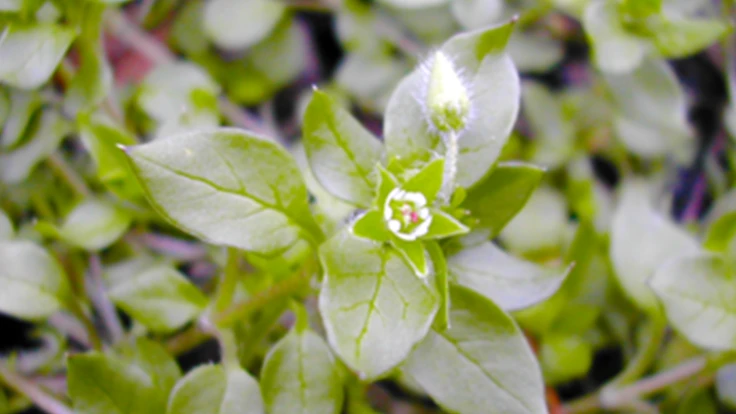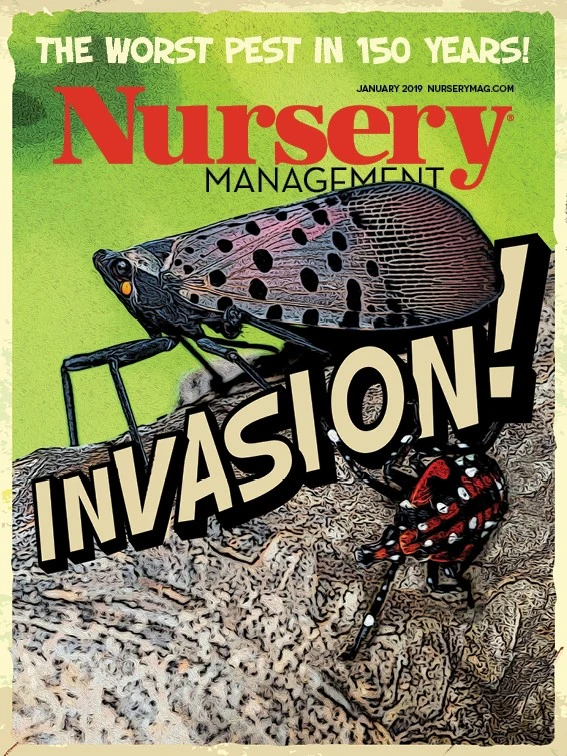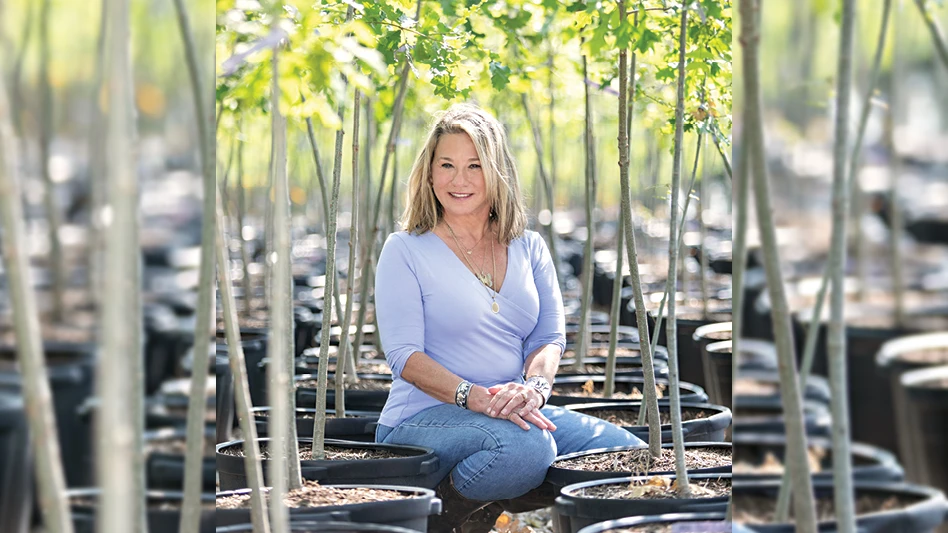
Weed control in nursery production, especially container production, should be preventative. Therefore, this top 10 list will pertain to why preemergence herbicides fail. And just like David Letterman, we will start with the 10th most common reason and end with the number-one most common reason.
10) You failed to read the label.
Herbicide labels contain a lot of information about application timing, rates, spray volume, soil conditions, and how to incorporate or activate the herbicide. Many of these topics are addressed below in one way or the other. If you don’t read the label, you are very likely to fall victim to one of the conditions described in # 9 through #1 of this article. Effective herbicide management begins with reading the label.
9) You disrupted the chemical barrier.
Preemergence herbicides form a chemical barrier over the soil/container surface. The barrier is typically ½ to 1 inch thick (depending on product, soil type, and method of incorporation). Fortunately, most weed seed germinate in the top ½ inch of the soil. Herbicides do not prevent weeds from germinating; instead they control weeds as they germinate within the chemical barrier.
Spilling containers, poking fingers in the media while moving containers, and walking or dragging objects across treated fields are common ways we disrupt the chemical barrier. Weed seed are ubiquitous. A million or more weed seed can be found in just ½ cubic meter of soil. A disruption in the chemical barrier provides an opportunity for weed seed to germinate.
8) Your herbicide combination (or lack thereof) did not cover a broad weed spectrum.
No single preemergence herbicide provides control of all weeds. Some herbicides are effective in controlling broadleaf weeds but provide poor control of grasses. These products would include formulations of isoxaben, simazine, or oxyfluorfen. Other products provide effective control of grasses and small seeded broadleafs, but poor control of many larger-seeded broadleafs. These products include any herbicide classified as a dinitroaniline, as well as napropamide, metolachlor, and dichlobenil. When spraying herbicides, use a product effective in controlling broadleafs mixed with another effective in controlling grasses. Some herbicides are simply ineffective in controlling one or more common weed species. For example, oxadiazon does not provide adequate control of common chickweed and other weeds in the same family. Pearlwort, one of the most troublesome weeds in containers, is another weed in this family that is reported to be poorly controlled by oxadiazon. Using two herbicides simultaneously should prevent an uncontrolled species.
Many granular herbicides contain two active ingredients for broad-spectrum control, some contain only one. Generally, two or more active ingredients provide improved control compared to just one. Check the labels of your granular herbicides to see which chemicals are used. And be sure the chemicals used provide control over the species prevalent in your nursery.

7) You failed to incorporate the herbicide with irrigation.
This is a crucial step in herbicide management. The herbicide label will provide instruction for how much irrigation to apply after application.
Many field growers are switching to drip irrigation, with some placing the drip tape underground. Capillary movement of water is insufficient to adequately incorporate the herbicide. Others have switched to some form of micro-irrigation in their large containers. Spray stakes and other forms of micro-irrigation generally do not provide water over the entire surface of the container, thus they are generally insufficient for incorporating herbicides. Whether in the field or in containers, adequate incorporation of the herbicide must occur with overhead irrigation or rain.
The labels of several herbicides state that as long as the herbicide is incorporated within 3 weeks, the herbicide will be effective. The most ideal circumstance in using rainfall for incorporating the herbicide would be to have a single rain event that provided the complete volume of water needed for incorporation. Many will assume that as long as the cumulative rainfall over 3 weeks is greater than ½ inch, the herbicide will be adequately incorporated. However, research on sandy soils has shown that if the soil is allowed to dry after the initial irrigation, the herbicide will bind to the soil and will not be prone to moving thereafter. So, repeated cycles of small rain events followed by intermittent dry spells will cause the herbicide to bind tightly to the top layer of the soil without adequately moving through the soil. The net effect is that the chemical barrier is very thin, and not deep enough to prevent weeds from germinating. Under these circumstances, it is possible for weeds to germinate under the thin chemical barrier.
6) You routinely over- watered your plants.
Over-watering will reduce herbicide efficacy. This is most problematic in container production, where over watering plants is commonplace. The exact reason why over-watering reduces herbicide efficacy is unclear, but I have a few good ideas. First, increased irrigation will leach the herbicide away from the container surface more rapidly, though I doubt this is a major reason due to the chemical properties of herbicides. Second, increased irrigation results in the container surface being more wet, which also causes increased microbial activity and increased microbial degradation of the herbicides (though, microbial degradation is not a major pathway for herbicides commonly used in containers). Third, and most important, is that excessive water allows weeds that would otherwise suffer from sub-lethal herbicide toxicity to survive. I recall many times pulling weeds from containers with very large shoot systems, and remarkably small root systems due to herbicide activity. These weeds should have died, however, excessive irrigation allowed them to escape control.
5) You tried to save a few pennies by using a lower herbicide rate.
There is a concentration in the soil at which a herbicide will inhibit weed growth. After applying the recommended herbicide rate (assuming uniform application and incorporation), there should be a chemical barrier in the soil with sufficient herbicide concentration that weeds will be inhibited from growing for roughly two to three months (depending on the herbicide). When lower than recommended rates are used, the herbicide concentration in the chemical barrier starts out low. And under typical degradation processes, it is soon degraded to the point where weeds can successfully germinate and grow.

4) You failed to use proper sanitation.
If you neglect sanitation, especially in container nurseries, forget about controlling weeds. Herbicides alone will fail to provide sufficient weed control.
Think of it as a game of probability. Even under the best circumstances, using the most effective herbicides applied at the proper time and in the proper manner, the chemical barrier will not be perfect. There will always be some small areas where the chemical barrier is insufficient for controlling weeds. In addition, the chemical barrier begins to break down almost immediately after application. Over time the chemical barrier becomes more dilute, and gaps will start to form. The more weed seed in your production system, the higher the probability that seed will find a weakened area and exploit it.
3) You topdressed fertilizers.
Topdressing fertilizer is a common practice in container production. It is also a practice that will likely lead to poor weed control. I set up a demonstration/experiment that evaluated 15 granular herbicides. It included 7 new and experimental products, along with 8 commonly used products (including Snapshot, RegalKade, OH2, Rout, etc.). For each container, I topdressed just 6 grams of Osmocote 18-6-12 (½ the recommended rate) and overseeded each container with bittercress seed. By 45 days after applying the herbicides, many containers were overrun with bittercress. None of the herbicides worked! The highest labeled rate was applied for each product, the herbicides were applied well before any seed germination, and the herbicides were properly incorporated with irrigation. Despite meticulous attention to details, the herbicides performed poorly.
Why does topdressing fertilizer tend to decrease herbicide effectiveness? It might be that increased microbial activity around elevated nitrogen concentrations (caused by topdressing) leads to accelerated microbial degradation of the herbicide. There is also a scant amount of research that suggests increased salinity reduces herbicide activity.
2) You did not calibrate your equipment.
Improper herbicide calibration will result in improper herbicide rates being applied to your crops. See #5 for more discussion on this.
Without regular sprayer calibration, you cannot know what rates are being applied. Be sure all the nozzles are clean, operating properly, and that each nozzle is emitting the same volume of spray. This is difficult to see with the naked eye. It requires you to capture spray from each nozzle to verify uniformity. If one nozzle is applying more or less than the others, it may lead to stripes or bands in the field with too little or too much herbicide.
Calibrating granular herbicide applicators is easy; however, making applications uniform is not. As mentioned previously, too much herbicide may cause plant injury, and too little herbicide will result in poor weed control. To improve application uniformity, consider applying the total amount of herbicide for a given area in at least two or three passes.
1) You applied herbicides to soil/containers that already had weeds.
This is hands down the number one reason why herbicides fail to provide weed control. A common excuse is that “there wasn’t enough time” to weed the containers before applying the herbicide. Herbicides registered for use in nursery crops will not kill existing weeds (except for spray-applied Goal, which is only labeled for conifers or directed sprays). Many of the herbicides used in nursery crops work by inhibiting root growth. But even small weeds generally have a deep, well developed taproot, which when greater than one inch deep will not be affected by herbicide activity.
Containers and fields must be weed free before applying preemergence herbicides. This is why I recommend an herbicide application soon after potting or planting. Many weeds germinate within days of receiving optimal environmental conditions. That is, after you’ve planted your fields, and in the process brought weed seed to the soil surface, many weeds can germinate within several days.
Get curated news on YOUR industry.
Enter your email to receive our newsletters.
Explore the January 2019 Issue
Check out more from this issue and find your next story to read.
Latest from Nursery Management
- The HC Companies, Classic Home & Garden merge as Growscape
- Eason Horticultural Resources will now officially be known as EHR
- BioWorks receives EPA approval for new biological insecticide for thrips, aphids, whiteflies
- Ellen Mackenbach-Lakeman appointed new CEO of Dümmen Orange
- Southern Garden Tour sets 2025 dates for trial garden open houses
- New book explores plants that thrive in Rocky Mountains
- American Floral Endowment establishes Herman Meinders Memorial Tribute
- These companies are utilizing plastic alternatives to reduce horticultural waste






